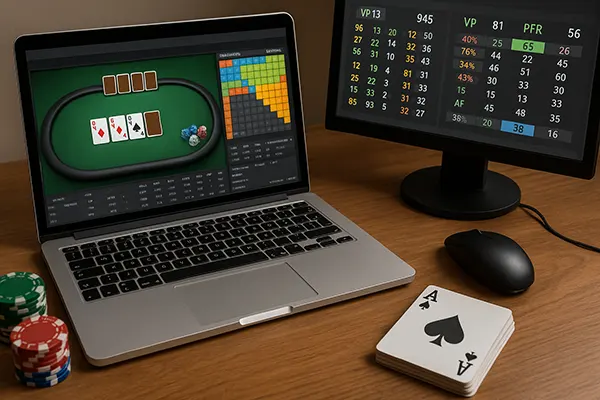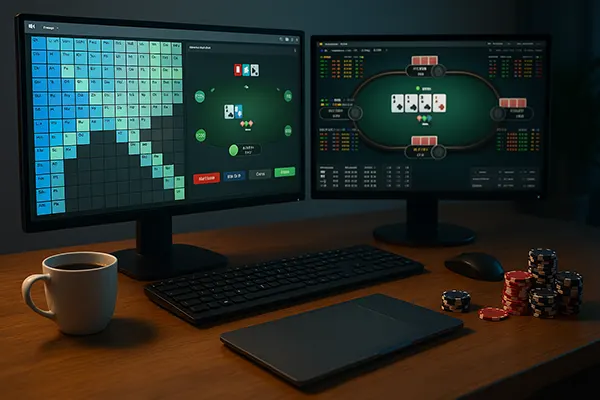
Technical Upgrade: Tools Modern Poker Players Rely on in 2025
In the high-stakes world of online poker, data analysis and precision decision-making are now indispensable. By 2025, even low-stakes grinders depend heavily on cutting-edge tools to maximise their win rate. Software once reserved for professionals is now widespread, empowering players with real-time data, optimal strategies, and detailed notes. Let’s dive into the essential tools shaping modern poker.
Poker Trackers and HUD Systems in 2025
Tracking software remains a backbone of serious poker play. In 2025, leading programs such as PokerTracker 5 and Hold’em Manager 4 offer seamless database integration, cloud-based syncing, and advanced filters. These trackers log every hand, opponent tendencies, and win/loss data, allowing players to identify leaks and study trends.
Integrated HUDs (Heads-Up Displays) have become more adaptive and discreet. Tools like Hand2Note dynamically adjust stats based on stack depth, table dynamics, and game format. This ensures that decision-making is both context-aware and legally compliant across various platforms that support third-party tools.
Compliance remains a hot topic. While most reputable online poker rooms allow trackers and HUDs, sites like GGPoker enforce strict restrictions. Players must adapt by using allowed hand history reviews and on-site analytics without live overlays.
How HUDs Offer Real-Time Advantage
Modern HUDs provide much more than VPIP and PFR statistics. In 2025, they visualise player profiles through colour-coded grids, heat maps, and frequency indicators. This helps players make precision decisions on whether to bluff, value-bet, or fold under pressure.
Advanced HUDs also feature ‘population tendency’ data—aggregated stats from thousands of hands in specific player pools. This is especially valuable in anonymous or zoom formats where traditional reads are unavailable.
Despite this, experienced players caution against over-reliance. The most effective use of HUDs complements intuitive play, rather than replacing it. Understanding when to diverge from the numbers is a hallmark of mastery.
Solvers and GTO Tools: The New Standard
Game Theory Optimal (GTO) solutions are no longer confined to high-stakes players. Thanks to solvers like PioSOLVER, GTO Wizard, and Simple Postflop, players at all levels now analyse hands post-session or even in real time, depending on site policy.
These tools simulate millions of scenarios to offer mathematically balanced strategies. By inputting stack sizes, bet sizes, and board textures, users receive optimal ranges and action frequencies for each situation. This enables deeper understanding of equilibrium play.
In 2025, GTO Wizard has led the way with browser-based, cloud-driven platforms. Their mobile optimisation allows even on-the-go analysis, including pre-flop chart libraries and built-in quizzes to drill common spots. This is vital for training muscle memory and avoiding costly mistakes.
The Legality and Ethics of Solver Use
Solvers are powerful but must be used responsibly. Real-time solver use is banned on most platforms. However, using them for off-table study is both legal and highly encouraged. Reputable players ensure they operate within TOS agreements to maintain fairness.
Ethically, solvers help level the playing field. They encourage disciplined thinking and reduce exploitative predation at lower stakes. Yet they also risk standardising play and creating robotic behaviours if used blindly.
Leading professionals recommend combining solver insights with exploitative adjustments tailored to specific opponents. This hybrid approach ensures maximum adaptability in live and online environments alike.

Notecaddy, Ranges, and Player Tagging Systems
Hand tracking and solvers are just part of the equation. Note-taking software like Notecaddy enhances reads by storing specific observations about player behaviour. In 2025, it’s integrated directly into major tracking suites, offering automatic note generation based on repeated actions.
Customisable tags and colour-coding systems help players categorise opponents at a glance. For example, a red tag might denote loose-passive players who limp often, while green identifies aggressive regulars. These visual cues speed up decision-making significantly during fast-paced games.
Moreover, pre-built range tools—like RangeTrainerPro or Flopzilla—assist in constructing and refining starting hands. These are especially useful for tournament players navigating ICM spots or 3-bet/fold dynamics.
Effective Use of Notes and Tags
Notes are only as useful as their specificity. Writing “calls too much” is vague; instead, a good note might read: “CCs 3x OOP vs BTN open w/ 76s — suspect postflop aggression.” Such detail builds a robust profile over time.
Tagging systems evolve with game history. Some software even offers AI-generated player summaries after a minimum number of hands, highlighting aggression frequencies, flop check-raise stats, and showdown behaviour.
By combining real-time data, post-session analysis, and precise tagging, players craft informed strategies tailored to each opponent. This is the essence of strategic modern poker in 2025.
